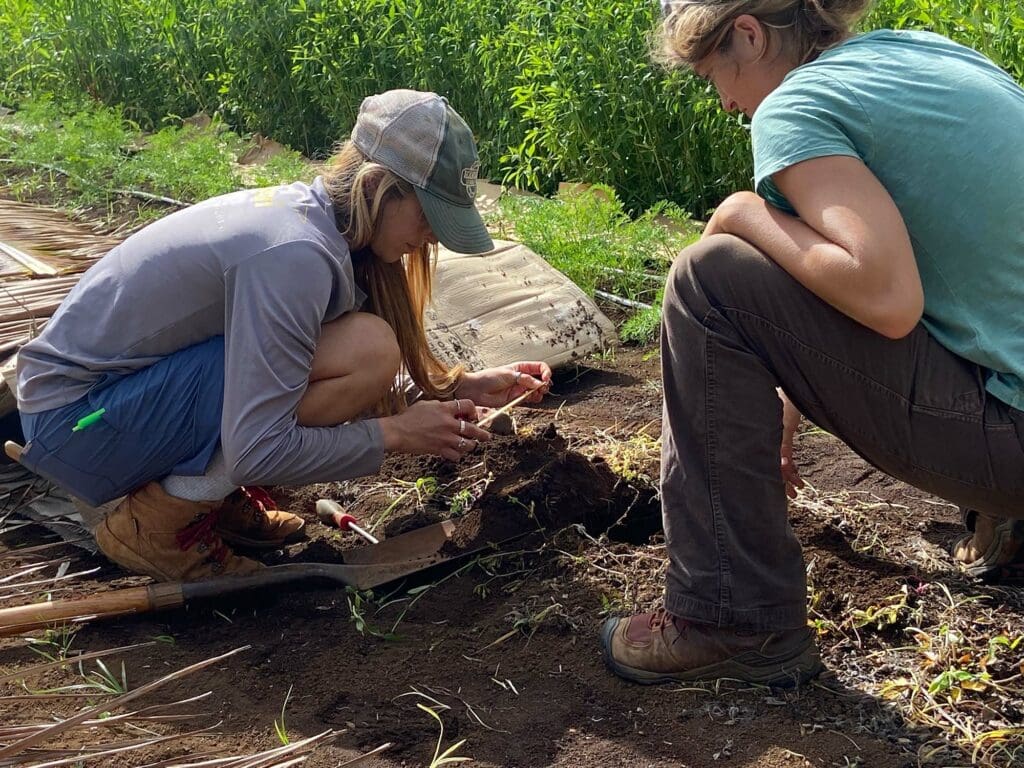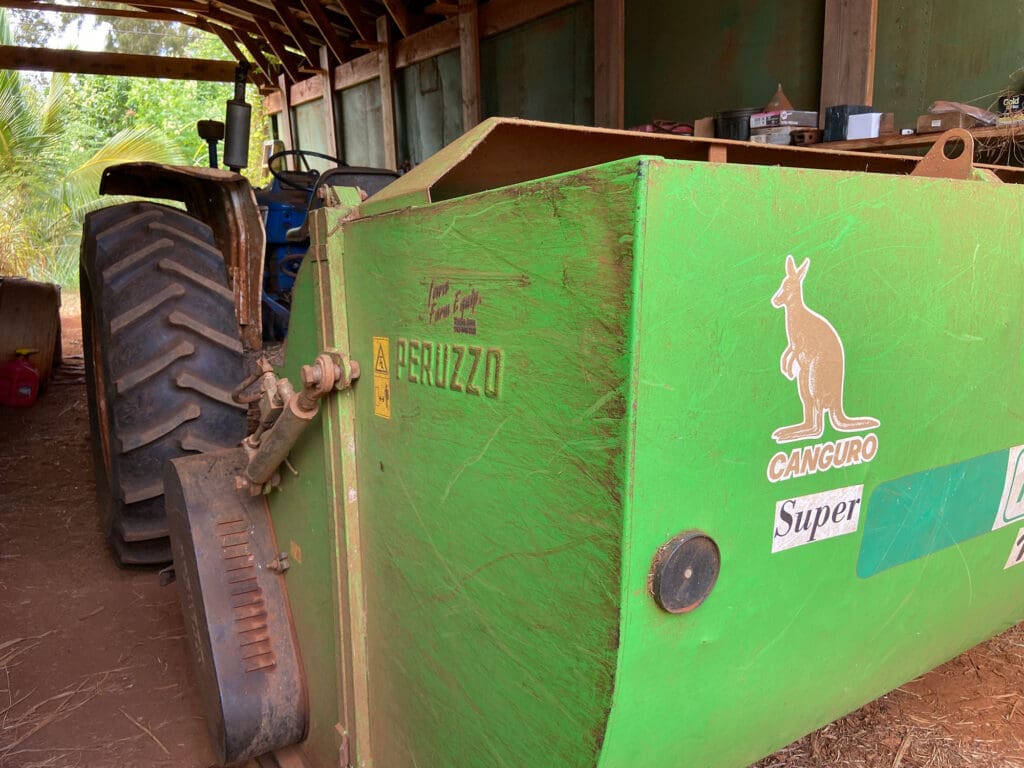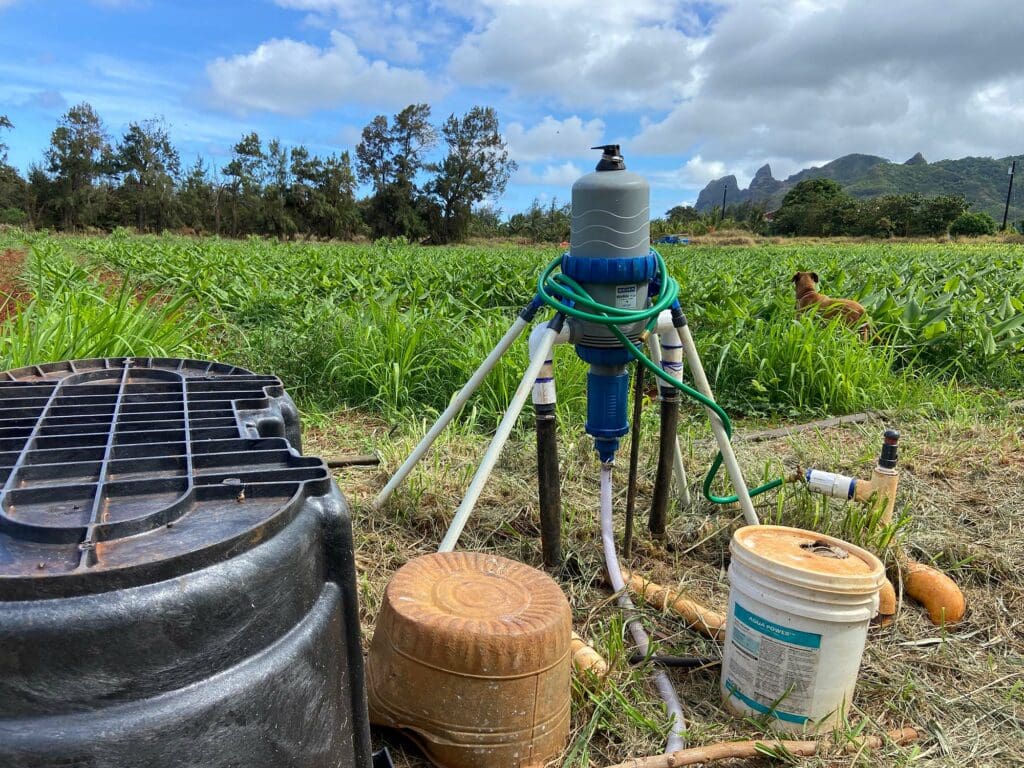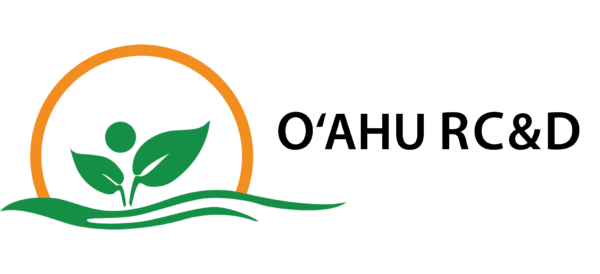Kauai Soil Health Innovator
Moloaʻa Organicaʻa
Operation Background:
In 2002, Ned and Martha Whitlock started Moloaʻa Organicaʻa Farm on the northeast shore of Kauaʻi. The pair are long-time organic and regenerative farmers with a keen interest in building up soil health. This diversified agricultural operation is on 28 acres with about 4 acres of mixed vegetables and a large tropical fruit orchard. Prior to their arrival, the land was used for sugarcane cultivation, followed by stints in pineapple and papaya before laying fallow for 20 years. When they obtained the land, it was overgrown with guinea grass and other invasive plants and challenged by soil with a high pH, poor soil tilth, nematodes, and mineral imbalances which are limiting nutrient cycling and vigorous plant growth and yields.
Past land use & management:
Prior to what has become Moloa’a Organica’a farm, the land was used for sugarcane cultivation, then pineapple, and then papaya. After years of growing pineapples, the soil became highly acidic and the past owners needed to raise the pH of their soil in order to grow papaya. The land was fallow for 20 years before Moloa’a Organica’a was started and Ned and Martha inherited land overgrown with guinea grass and other invasives.

Natural resource and production challenges:
The farm has fine, gently sloping Oxisols from the Lihue soil series which is a low activity clay. These highly weathered soils require nutrient additions to be agriculturally productive. Ned and Martha are challenged by soil with a high pH, poor tilth, nematodes, and mineral imbalances which are limiting nutrient cycling and vigorous plant growth and yields.
Lab work completed by the UH Soil Health Environment and Ecosystem Resilience Lab confirms what Ned and Martha have had trouble with. The lab analysis indicated that the pH of their soil sample value was higher than the median pH; the bulk density of their soil is lower than the median value; the total organic carbon and the hot water extraction are higher than the median value. Their soil fertility report also showed an excess of Phosphorus, which is locking up iron and other trace minerals, and an excess of Manganese which is causing other mineral imbalances, including iron deficiency.
Current Soil Health Goals and Management Considerations in Selecting Soil Health Practices:
Ned and Martha have upheld organic and regenerative farming methods for many years, trying out quite a few different practices. Ned and Marthaʻs soil health practices include building Hugelkultur beds, crop rotation, cover crops, adding compost to increase organic matter, using JADAM (a Korean Natural Farming amendment) and comfrey soaks. They use nitrogen-fixing green manure plants as part of their design. After adding chicken manure to compost, there was an excess in phosphorus, making iron and other important trace minerals unavailable. In response, Ned and Martha were forced to explore other options for adding nutrients, such as applying a foliar spray to address nutrient deficiencies and using a Peruzzo 1800 Canguro flail mower every other week to collect and place grass clippings as mulch. Upon laboratory analysis of their soil fertility, an excess of phosphorus was revealed. This caused Ned to explore making his own nitrogen fertilizer and using a compost designed to have a lower C:N ratio to mitigate nitrogen immobilization. He has tried to find ways to add more nitrogen into their system but has struggled with finding sources that are both vegan and affordable. After participating in the Kaua’i farmer soil health cohort and reviewing their lab resulst from the UH S(HEE)R – Soil Health Environment and Ecosystem Resilience Lab, Ned and Martha’s specific soil health goals are to improve their soil structure/tilth, increase organic matter, and manage nutrients to optimize plant growth and yield.
Over the years, Martha and Ned have trailed a variety of soil health practices. In selecting practices, they have to consider the costs and benefits of each one, which include financial costs, type and amount of labor required, pest and disease pressure associated with the practice, and more. They have also learned that not all practices are one-size-fits-all for their entire operation, but are more appropriate when applied on specific fields or crops. In the end, the couple has learned that selecting soil health practices is highly nuanced. What works in one field or for one season may not always be replicable throughout the farm or year. Nutrient management considerations are a large part of the decision-making process for farmers like Ned and Martha when choosing soil health practices.
For instance, making sure pH is in an ideal range can help to increase soil microbial activity and nutrient cycling. At Moloa’a Organica’a, their soil has a pH that is higher than ideal, so Ned and Martha are considering using an acidifier and actively working with the local CTAHR extension agents to explore the best management practices for adding sulfur to their soil. Since soil health is a priority for Ned and Martha, they must weigh this practice carefully to ensure they do not damage the mycelium that they have worked to build-up in their fields.
Additionally, their Hawaii Soil Health Lab Report indicates that their carbon is higher than average for Oxils in the Lihue series, which indicates the soil is trending towards nitrogen immobilization. For this reason they are looking for ways to balance out the C:N ratio through cover crop and perennial ground covers that provide plant-available nitrogen (PAN) to their crops. They may also need to find an alternate source of nitrogen fertilizer to the chicken manure they had been using, which led to an excess of phosphorus, making iron and other important trace minerals unavailable. They are exploring making their own nitrogen fertilizer using a compost design with a heavy nitrogen ratio over carbon. They have had two failed attempts at growing duckweed (azolla) as a high nitrogen addition to their compost. This could possibly be due to the growing location not receiving enough sun, because of alkaline water, or from Manganese toxicity. Ned is also looking at green mulch as a potential source of N, using the flail mower attachment that breaks up pruned branches into smaller mulch sources. Other potential sources of nitrogen include pelletized tankage and seed meal – ideally flax. Implementing soil health practices on any farm can be deeply beneficial both for farm operations and the surrounding ecosystem. However, many farmers know that choosing and applying the right practices for your operation is no simple undertaking. Soil health practices need to be carefully chosen based on a number of factors including soil health goals, local conditions and resource concerns, as well as cost effectiveness. Once chosen, soil health practices have to be applied and monitored carefully, as they are often effective only under specific conditions.For example, a farmer might choose to plant cowpea as a cover crop in order to increase the amount of plant available nitrogen in their soil, crowd out weeds and attract beneficial insects. If the cowpea is not monitored properly and terminated at the correct time, it can attract aphids and increase the pest pressure in that area, becoming counterproductive to the farmer. One of the most important and nuanced considerations for farmers exploring soil health practices is cost. It may be easy to think of costs in terms of dollar amounts, but other costs—like access to particular resources, or the potential for increased pest and disease pressure—are major factors farmers must consider in selecting the most appropriate practice. For instance, if a farmer has access to low-cost organic fertilizer, installing a cover crop as a nitrogen source may not actually be the most cost effective path at that time. If the fertilizer price rises in the future, the cover cropping practice may then become the more economically feasible option. Additionally, in a diversified operation, a farmer may be able to use a species of cover crop in one field that grows a specific type of crop, but may not be able to use that same species in a different field that produces a different type of crop due to the threat of pests or disease. Along these lines, farmers also often have to consider the costs and benefits of soil health practices on a field-by-field basis. A soil health practice that is beneficial for one area of their operation or during one particular year may not be for another area or a subsequent year due to changing circumstances. Ned and Martha Whitlock of Moloa’a Organica’a Farm have been farming and innovating soil health practices for 30 years. Their story makes it clear the value of continuing to consider and experiment with different soil health practices over time. Most importantly, they exemplify how each practice must be chosen and adapted specifically for the conditions at the farm.

New Soil Health Practices:
To combat soil health challenges, the Whitlocks are considering doing a deep bio-tillage using brassica cover crops (ex. Oil radish, brown mustard, daikon). This soil health practice is intended to improve soil structure and tap into the soil below the root zone of other crops. Brassicaceous cover crops have biofumigant properties that are known to suppress soil-borne pests and pathogens and may act as a nematode crop trap. Biofumigation with brown mustard and soil drenching enhances bacterial and fungal decomposition while improving soil nutrient cycling, helping correct mineral imbalances that limit plant growth and yield. Farmers often use compost to increase organic matter in their soil. Unfortunately, compost from local sources has a high pH, but Ned and Martha are trying to lower their pH. The two are exploring best management practices for adding sulfur to the soil, being sure not to add so much that it damages mycelium. As participants in Oʻahu RC&D’s Soil Health Network, the Whitlocks are eligible for funding that they are considering to use to purchase and install a fertigation system. This saves time and money and enabling them to add biology, carbon and fertilizer amendments all at once.
Practice 1: Carbon and Biological Tea Fertigation
Adding liquid forms of carbon, nitrogen and ‘pre and probiotics’ helps balance the C:N ratio in the soil and ensure there is enough carbon and nitrogen to support the intake needs of the crops and biology in the soil. Diversified forms of carbon and nitrogen are an important practice to increase the diversity of soil microbes. Since soil microbes serve different functions and make different types of minerals in the soil ‘plant available’, increasing the activity, amount and diversity of soil biology directly improves nutrient cycling and availability.
After years of applying Jadam and liquid forms of nitrogen to their fields and observing positive responses in the health and yield of their crops, Ned and Martha viewed this soil health practice as worthwhile. However, manually applying these liquid forms of fertilizers and amendments to their fields was labor intensive and cost-prohibitive.
They decided to continue to adapt this practice on their farm but to improve the application method with a Mixrite fertigation system that was purchased using funds from their participation in the Kauai Farmer Soil Health Cohort. To learn more about their system and costs, please see the images and cost-break-down below.

Comparing the cost of this soil health practice when applied through manual labor versus a fertigation system:
Estimating the labor cost of four farm employees at a rate of $15 per hour, hand-applying a quarter acre is $60 per application. Assuming that this liquid form of fertilizer is readily taken-up by crops and soil biology and should be applied every week results in a cost of $60 per week x 52 weeks per year = $3,120 annual cost in labor per quarter acre. The Mixrite fertigation systems range from $500-$2500. For the Whitlocks, this means that the cost of their fertigation system will ‘pay for itself’ in 6 months.
It’s clear from Moloa’a Organica’a’s experience that a soil health practice may not be affordable using one type of application method (i.e. fertilizing by hand), but can become cost effective if you can rescue the cost of labor. Investing in a piece of equipment or machinery is a great way to lower labor costs.
Practice 2: Cover crop system for pest management
Martha and Ned already have cover crops as part of their system. However, since they struggle with nematodes, they are considering using annual cover crops for their biofumigant properties, starting with radish and brown mustard. CTAHR researchers recommend using Brassicaceous cover crops to suppress soil-borne pests and pathogens. Oil Radish is suppressive to plant parasitic nematodes. The recommendation for farms at their elevation is to plant Oil Radish at 10 lbs/acre. Ned and Martha may also apply Brown mustard at 7-10 lbs/acre. Biofumigation with brown mustard and soil drenching enhances bacterial and fungal decomposition and improves soil nutrient cycling. They will use their flail mower attachment to terminate the cover crop and then till it into the soil. Then covering the soil with clear plastic solarization mulch will likely enhance the nematode suppression effects.
Funding Sources
Martha and Ned used funding through Oahu RC&D’s Soil Health Cohort to purchase and install their fertigation system. This will save them time and money so they can add biology, carbon and fertilizer amendments all at once.
Note: As part of Oʻahu Resource Conservation and Development Council’s Soil Health Training Cohort, we are proud to feature some of the innovative practices local farmers are using to regenerate and restore soil health and on-farm ecological services. To learn more about this initiative, please visit our website.
This material is based upon work supported by the U.S. Department of Agriculture, under agreement number NR2192510002C002. Any opinions, findings, conclusions, or recommendations expressed in this publication are those of the author(s) and do not necessarily reflect the views of the U.S. Department of Agriculture. In addition, any reference to specific brands or types of products or services does not constitute or imply an endorsement by the U.S. Department of Agriculture for those products or services.
Resources and References:
- Mulder’s Chart
Mulder’s Chart describes the ways that different nutrients interact with each other in agricultural soils, including how the presence of one nutrient can lead to the decreased availability of another. - Biofumigation approaches to help farmers reduce soil-borne disease pathogen problems in agroecosystems
This CTAHR presentation describes how biofumigation with various cover crops can provide effective, affordable, and profitable ways to control pests like reniform and root-knot nematodes in Hawaii crops while improving soil health. It outlines numerous experiments that show the efficacy of allelopathic cover crops and biofumigation at controlling soil-borne disease pathogen problems in certain crops, and includes specific methods for biofumigation and results. - An Update on Biofumigation Research in Hawaii: The equipment matters!
In this experiment, CTAHR extension staff found that the equipment with which you terminate your biofumigant cover crops affects their nematode suppressing effects. They found that with Brown Mustard, using a flail mower is more effective than a chipper to suppress root-knot and reniform nematodes. - Cover Crop Chart for Hawaii
This cover crop selection chart lays out various types of cover crop used in Hawaii along with their various characteristics and uses, including whether they are a grass, broadleaf, or legume, their preferred elevation, seeding rate, annual or perennial status, and whether or not they are resistant to root-knot, reniform nematodes, and/or are suppressive to plant-parasitic nematodes. - Trap Cropping and Biofumigation for Plant-parasitic Nematode Management
This 2018 pamphlet by Philip Waisen and Koon-Hui Wang at UH Manoa explains best practices for cover cropping with oil radish and brown mustard to control plant-parasitic nematodes, including planting and terminations methods for best results. - Liming Acid Soils of Hawaii
CTAHR extension publication that provides the lime requirements for various acidic soils in Hawaii. - Beneficial Use of Biochar to Correct Soil Acidity
CTAHR paper exploring the use of biochar to replace lime in addressing soil acidity.

